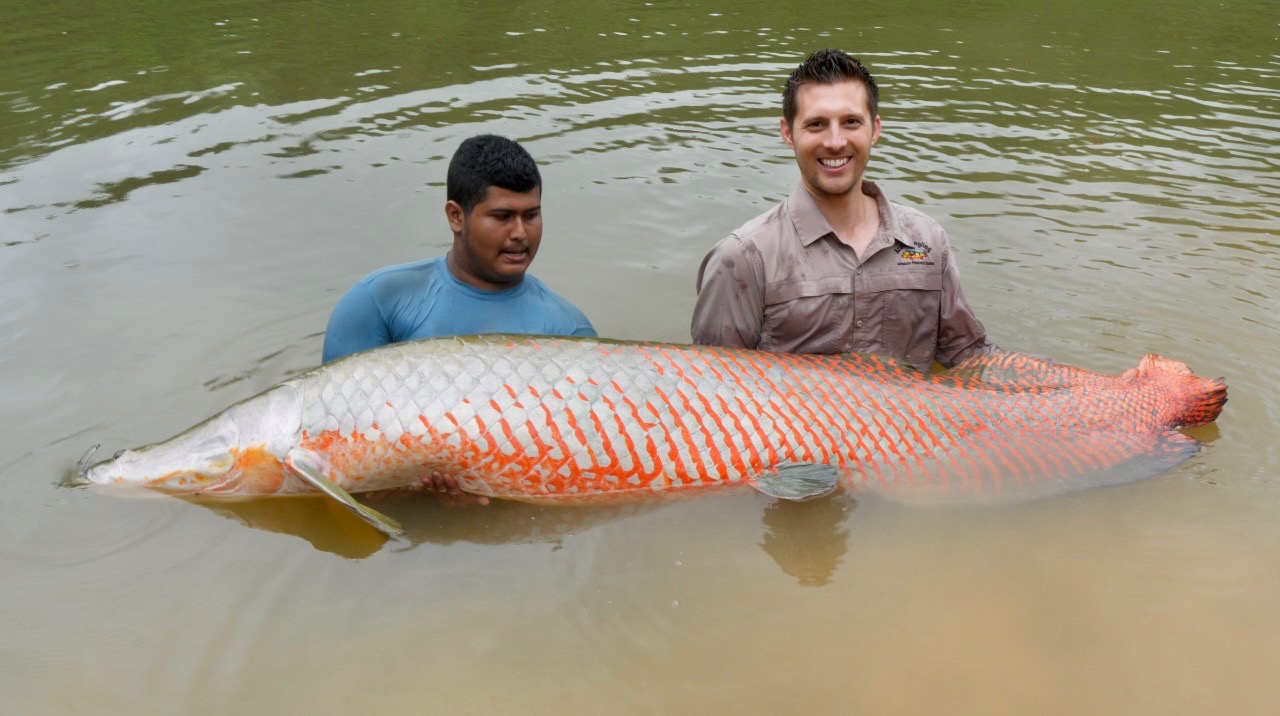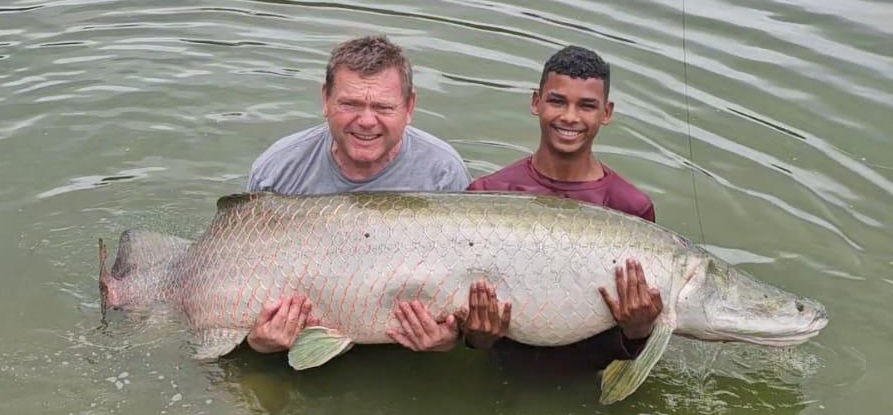[email protected] | 866-832-2987
Arapaima
The Breathing Giant of the Amazon
Arapaima
The Breathing Giant of the Amazon
Guide
The Arapaima, also known as pirarucu or paiche, is a true titan of the Amazon Basin—and one of the largest freshwater fish species on Earth. These ancient, air-breathing predators can grow over 8 feet long and exceed 400 pounds. With a powerful, torpedo-shaped body and stunning red-orange tail highlights, they are both beautiful and imposing.
Adapted to low-oxygen environments, arapaima use a modified swim bladder to breathe atmospheric air—surfacing every 15 to 20 minutes with an audible gulp. Their body is cylindrical and thick at the front, narrowing toward a short, rounded tail. Their skin is armored with large, overlapping cycloid scales, and their mouth is lined with rows of fine, comb-like teeth. This physical resilience, combined with explosive surface strikes, makes them an unforgettable opponent.
Although they're largely piscivorous—preying on smaller fish, crustaceans, and even birds or reptiles—arapaima also exhibit seasonal dietary shifts. During the wet season, they venture into flooded forests to forage. When targeting them with lures or bait, anglers must match this behavior and strike with stealth and precision.
Interesting Facts & Notes
Arapaima are obligate air-breathers. Up to 78% of their oxygen uptake comes from the air—not water. If they can't surface, they drown.
They practice parental care, with males protecting eggs and fry in their mouths or close by.
Capable of leaping clear of the water, they can shake off hooks with violent headshakes.
Despite their size, arapaima are known to feed gently—often inhaling prey or bait with subtle suction.
Where to Catch Arapaima
Though not a primary target on most trips, they can be added as an exciting day trip:
Arapaima Day Trip (Manaus region) – Fish alongside local expert Pastor Odali
Quick Facts
| Attribute | Description |
|---|---|
| Scientific Name | Arapaima gigas |
| Common Names | Arapaima, Pirarucu, Paiche |
| Size Range | Common: 5–7 ft / 100–300 lbs; Max: 440 lbs+ |
| Region | Amazon & Araguaia–Tocantins basins |
| Habitat | Floodplain lakes, oxbows, submerged forests |
| Behavior | Solitary, air-breathing, ambush predator |
| Coloration | Dark green-black with red-orange tail and flanks |
| Aggression | Moderate – ambush hunter but not overly aggressive |
| Feeding Habits | Carnivorous – fish, crustaceans, birds, small mammals |
| Gamefish Status | High – explosive strikes, powerful fight, air jumps |
Physical Appearance
Arapaima have a robust, elongated, and cylindrical body with a broad head and upward-facing mouth. Their dorsal and anal fins are set far back on the body, helping generate strong thrusts for surface attacks and powerful jumps. The most distinctive feature is their coloration: a dark olive-green body that fades to black toward the tail, accented by a brilliant red to orange gradient on the lower flanks and tail.
Their large, plate-like cycloid scales give the fish a prehistoric appearance and offer substantial protection. Arapaima skin has long been used locally for making durable leather goods.

How to Identify Arapaima
Long, torpedo-shaped body with a blunt head and large mouth
Dark upper body with red-orange hues on the flanks and tail
Small, streamlined pectoral fins; dorsal and anal fins set far back
Frequently surfaces with a loud gulp to breathe air
Armored with large, overlapping cycloid scales
How to Catch Arapaima
Catching arapaima is a unique challenge requiring both skill and local knowledge. Because they are surface-breathing, anglers often fish “visually,” casting when the fish rise to gulp air. Because arapaima have bony mouths and are adept at throwing hooks, strong hooksets and constant pressure are essential.
Recommended Techniques
Jigs, sinking soft plastics, flies, and shallow jerkbaits when fish are active
Live bait or cut bait fished near structure
Large streamers on a 10–12 wt fly rod for aggressive fish
Suggested Gear
Rod: Heavy baitcasting or spinning; 10–12 wt fly rod
Line: 80–100 lb braid
Leader: Heavy mono or fluoro, 80 lbs
Hooks: Strong circle or J hooks, size 8/0–12/0

Arapaima In Action
Related Reading
Join the Adventure
Come face to face with the Amazon’s largest scaled predator—on an epic fishing adventure.
Contact us today:
📞 (866) 832-2987
References
Zeinad, A. K. & Prado, R. A. (2012). Peixes fluviais do Brasil: espécies esportivas
Goulding, M. (1981). Amazon: The Flooded Forest
Ferraris, C.J. Jr. (2003). Checklist of Catfishes
Nelson, J.S. (2006). Fishes of the World
Santos, G.M. et al. (2006)
Ferreira, E.J.G. et al. (1998)
Nature Scientific Data Article – Amazon Freshwater Fishes
Peacock Bass (Google Books)
